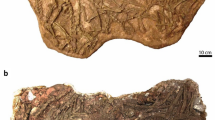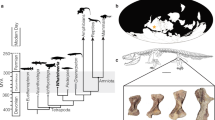Abstract
How evolutionary changes in body size are brought about by variance in developmental timing and/or growth rates (also known as heterochrony) is a topic of considerable interest in evolutionary biology1. In particular, extreme size change leading to gigantism occurred within the dinosaurs on multiple occasions2. Whether this change was brought about by accelerated growth, delayed maturity or a combination of both processes is unknown. A better understanding of relationships between non-avian dinosaur groups and the newfound capacity to reconstruct their growth curves make it possible to address these questions quantitatively3. Here we study growth patterns within the Tyrannosauridae, the best known group of large carnivorous dinosaurs, and determine the developmental means by which Tyrannosaurus rex, weighing 5,000 kg and more, grew to be one of the most enormous terrestrial carnivorous animals ever. T. rex had a maximal growth rate of 2.1 kg d-1, reached skeletal maturity in two decades and lived for up to 28 years. T. rex's great stature was primarily attained by accelerating growth rates beyond that of its closest relatives.
This is a preview of subscription content, access via your institution
Access options
Subscribe to this journal
Receive 51 print issues and online access
$199.00 per year
only $3.90 per issue
Buy this article
- Purchase on Springer Link
- Instant access to full article PDF
Prices may be subject to local taxes which are calculated during checkout


Similar content being viewed by others
Change history
16 December 2015
A Correction to this paper has been published: https://doi.org/10.1038/nature16487
References
Gould, S. J. Ontogeny and Phylogeny (Harvard Univ. Press, Cambridge, Massachusetts, 1977)
Carrano, M. T. in Amniote Paleobiology: Perspectives on the Evolution of Mammals, Birds, and Reptiles (eds Carrano, M. T., Blob, R. W., Gaudin, T. & Wible, J.) (Univ. Chicago Press, Chicago, in the press)
Erickson, G. M., Curry-Rogers, K. & Yerby, S. Dinosaur growth patterns and rapid avian growth rates. Nature 412, 429–433 (2001)
Brochu, C. A. Osteology of Tyrannosaurus rex: Insights from a nearly complete skeleton and high-resolution computed tomographic analysis of the skull. J. Vert. Paleontol. Mem. 22(7), 1–138 (2003)
Carrano, M. T. & Hutchinson, J. R. Pelvic and hindlimb musculature of Tyrannosaurus rex (Dinosauria: Theropoda). J. Morphol. 253, 207–228 (2002)
Brochu, C. A. A digitally rendered endocast for Tyrannosaurus rex. J. Vert. Paleontol. 20, 1–6 (2003)
Currie, P. J. Possible evidence of gregarious behavior in tyrannosaurids. GAIA 15, 271–277 (1998)
Erickson, G. M. Breathing life into Tyrannosaurus rex. Scient. Am. 9, 42–49 (1999)
Chin, K., Tokaryk, T. T., Erickson, G. M. & Calk, L. C. A king-sized theropod coprolite. Nature 393, 680–682 (1998)
Erickson, G. M. et al. Bite-force estimation for Tyrannosaurus rex from tooth-marked bones. Nature 382, 706–708 (1996)
Hutchinson, J. & Garcia, M. Tyrannosaurus was not a fast runner. Nature 415, 1018–1021 (2002)
Holtz, T. R. in Mesozoic Vertebrate Life (eds Tanke, D. & Carpenter, K.) 64–83 (Indiana Univ. Press, Bloomington, 2001)
Currie, P. J. Cranial anatomy of tyrannosaurid dinosaurs from the Late Cretaceous of Alberta, Canada. Acta Palaeontol. Pol. 48, 191–226 (2003)
Chinsamy, A. Physiological implications of the bone histology of Syntarsus rhodesiensis (Saurischia: Theropoda). Palaeontol. Afr. 27, 77–82 (1993)
Weishampel, D. B. & Horner, J. R. in Dinosaur Eggs and Babies (eds Carpenter, K., Hirsch, K. F. & Horner, J. R.) 229–243 (Cambridge Univ. Press, Cambridge, 1994)
Francillon-Viellot, H., et al. in Biomineralization: Patterns and Evolutionary Trends (ed. Carter, J. G.) 471–530 (Van Nostrand Reinhold, New York, 1990)
Larson, P. & Donnan, K. Rex Appeal (Invisible Cities Press, Montpelier, 2002)
Horner, J. R. & Lessem, D. The Complete T. rex (Simon & Schuster, New York, 1993)
Currie, P. J., Hurum, J. H. & Sabath, K. Skull structure and evolution in tyrannosaurid dinosaurs. Acta Palaeontol. Pol. 48, 227–234 (2003)
Carr, T. D. Craniofacial ontogeny in Tyrannosauridae (Dinosauria, Coelurosauria). J. Vert. Paleontol. 19, 497–520 (1999)
Castanet, J. & Naulleau, G. Données expérimentales sur la valeur des marques squelettiques comme indicateur de l' age chez Vipera aspis (L.) (Ophidia, Viperidae). Zool. Scripta 3, 201–208 (1974)
de Buffrenil, V. & Castanet, J. Age estimation by skeletochronology in the Nile monitor (Varanus niloticus), a highly exploited species. J. Herpetol. 34, 414–424 (2000)
Maddison, W. P. & Maddison, D. R. MacClade Version 3; Analysis of Phylogeny and Character Evolution (Sinauer Associates, Sunderland, MA, 1992)
Anderson, J. F., Hall-Martin, A. & Russell, D. A. Long bone circumference and weight in mammals, birds, and dinosaurs. J. Zool. A 207, 53–61 (1985)
Sussman, M. Growth and Development (Prentice-Hall, Englewood Cliffs, New Jersey, 1964)
Coria, R. A. & Salgado, L. A new giant carnivorous dinosaur from the Cretaceous of Patagonia. Nature 377, 224–226 (1995)
Erickson, G. M., de Ricqles, A., de Buffrenil, V., Molnar, R. E. & Bayless, M. A. Vermiform bones and the evolution of gigantism in Megalania—how a reptilian fox became a lion. J. Vert. Paleontol. 23, 966–970 (2003)
Case, T. E. On the evolution and adaptive significance of post-natal growth rates in the terrestrial vertebrates. Q. Rev. Biol. 53, 243–282 (1978)
Seebacher, F. A new method to calculate allometric length-mass relationships of dinosaurs. J. Vert. Paleontol. 21, 51–60 (2001)
Currie, P. J. Allometric growth in tyrannosaurids (Dinosauria: Theropoda) from the Upper Cretaceous of North America and Asia. Can. J. Earth Sci 40, 651–665 (2003)
Acknowledgements
We thank O. Rieppel and B. Simpson (The Field Museum), L. Chiappe (Los Angeles County Museum of Natural History), P. Larson and N. Larson (Black Hills Institute), B. Stein and M. Triebold (Triebold Paleontology), D. Evans (Indianapolis Children's Museum), C. Mehling (American Museum of Natural History), S. Williams, M. Henderson and L. Cranford (Burpee Museum of Natural History), J. Gardner, D. Tanke and D. Brinkman (Royal Tyrrell Museum of Palaeontology), T. Carr (University of Toronto), F. W. King and K. Krysco (Florida Museum of Natural History), K. Womble (Florida State University), M. Bayless (Berkeley, California) and A. Woodward (Florida Fish and Wildlife Conservation Commission) for assistance with this research. The NSF and the College of Arts and Sciences of Florida State University generously funded this project.
Author information
Authors and Affiliations
Corresponding author
Ethics declarations
Competing interests
The authors declare that they have no competing financial interests.
Supplementary information
Supplementary Information
Contains (1) the number of substantial finds of Tyrannosaurus rex; and (2) body mass estimation in non-avian dinosaurs. (DOC 21 kb)
Rights and permissions
About this article
Cite this article
Erickson, G., Makovicky, P., Currie, P. et al. Gigantism and comparative life-history parameters of tyrannosaurid dinosaurs. Nature 430, 772–775 (2004). https://doi.org/10.1038/nature02699
Received:
Accepted:
Issue Date:
DOI: https://doi.org/10.1038/nature02699
This article is cited by
-
The Tyrant Lizard King, Queen and Emperor: Multiple Lines of Morphological and Stratigraphic Evidence Support Subtle Evolution and Probable Speciation Within the North American Genus Tyrannosaurus
Evolutionary Biology (2022)
-
The first theropod dinosaur (Coelurosauria, Theropoda) from the base of the Romualdo Formation (Albian), Araripe Basin, Northeast Brazil
Scientific Reports (2020)
-
A comprehensive diagnostic approach combining phylogenetic disease bracketing and CT imaging reveals osteomyelitis in a Tyrannosaurus rex
Scientific Reports (2020)
-
Microanatomy of the stem-turtle Pappochelys rosinae indicates a predominantly fossorial mode of life and clarifies early steps in the evolution of the shell
Scientific Reports (2019)
-
Diminutive fleet-footed tyrannosauroid narrows the 70-million-year gap in the North American fossil record
Communications Biology (2019)
Comments
By submitting a comment you agree to abide by our Terms and Community Guidelines. If you find something abusive or that does not comply with our terms or guidelines please flag it as inappropriate.



